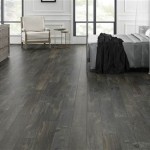Installing Cork Flooring For A Warm And Durable Concrete Surface
With its exceptional insulation, resilience, and sound absorption properties, cork flooring offers a unique and desirable flooring solution for concrete surfaces. Here's a comprehensive guide to installing cork flooring on concrete, ensuring a warm, durable, and comfortable living space.
Step 1: Preparing the Concrete Surface
Before installing cork flooring, it's crucial to ensure the concrete surface is level, dry, and free of imperfections. Check for any dips or bumps using a straight edge; if detected, fill them with a concrete leveling compound. Allow the patching compound to cure completely before proceeding.
Additionally, test the concrete's moisture content using a moisture meter. The moisture level should be below 4% for successful installation. If the moisture level is higher, consider using a vapor barrier to prevent moisture from seeping into the flooring.
Step 2: Installing an Underlayment
Installing an underlayment is essential for moisture resistance, sound absorption, and thermal insulation. Choose an underlayment compatible with cork flooring, such as a polyethylene foam underlayment or a cork underlayment. Roll out the underlayment over the entire concrete surface, ensuring it covers all edges and corners.
Step 3: Choosing and Installing Cork Flooring
Select cork flooring that meets your desired thickness, texture, and finish. Cork flooring is typically available in tiles, planks, or rolls. Start installing the flooring from a corner and work your way outward. Use a tapping block to gently secure the planks or tiles together, ensuring they are tightly fitted.
For tiles, apply a thin layer of adhesive to the back before placing them on the underlayment. Ensure proper alignment and spacing between the tiles using spacers.
Step 4: Finishing Touches
Once the cork flooring is installed, allow it to settle for 24-48 hours before adding any trim or moldings. Trim the excess underlayment and install baseboards and moldings to complete the installation.
Benefits of Cork Flooring on Concrete
- Warmth and Insulation: Cork is a naturally warm material, providing excellent insulation and reducing heat loss through the concrete floor.
- Durability: Cork flooring is highly resistant to wear and tear, making it suitable for high-traffic areas. It can withstand heavy furniture and occasional spills.
- Sound Absorption: Cork's cellular structure effectively absorbs sound, reducing noise transfer between rooms and creating a quieter environment.
- Moisture Resistance: With an additional vapor barrier, cork flooring can be installed in areas with moderate moisture levels, making it suitable for basements or moisture-prone areas.
- Environmental Sustainability: Cork is a renewable resource, making it an eco-friendly flooring choice that supports sustainable forestry practices.
Maintenance and Care
To maintain the beauty and durability of your cork flooring, follow these simple maintenance tips:
- Sweep or vacuum regularly to remove dirt and dust.
- Use a damp mop with a mild cleaning solution for occasional cleaning.
- Avoid using abrasive cleaners or harsh chemicals that can damage the cork's surface.
- Re-seal the flooring every 3-5 years to protect it from moisture and wear.
By following these steps, you can successfully install and maintain cork flooring on a concrete surface, creating a warm, durable, and comfortable living space.

Cork Flooring Pros And Cons Is It The Right Choice For You

Cork Flooring Guide Specifics Pros Cons Fantastic Handyman Au

Complete Guide To Cork Flooring Installation Deerfoot Carpet

Basement Cork Flooring Pros Cons Best Brands Home

Diy Cork Flooring Pros Cons Green Installation Guide For Leed Passive House Ecohome

Best Basement Flooring Options Cork Floating Floors Icork Floor

Cork Flooring Installation How To Do It Diy Home Improvement

A Buyers Guide And Deep Dive For Cork Flooring Icork Floor

7 Reasons You Should Consider Cork Flooring For Basements

How I Saved Over 700 On Cork Flooring For The Basement
See Also







